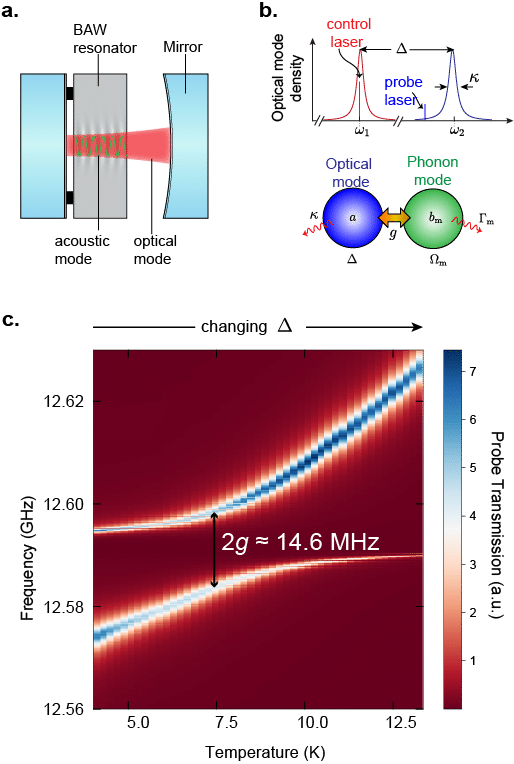
Optomechanical Strong Coupling Between Infrared Light and Bulk Acoustic Phonons
2Department of Physics, Yale University
Utilizing inter-modal Brillouin-like interaction within an optical cavity, we demonstrate strong coupling between infrared light and high-frequency (12.6 GHz) bulk acoustic phonons. This demonstration opens new avenues for robust optical control of high-frequency phonons.
email: prashanta.kharel@yale.edu
The interaction between light and sound has been utilized for applications ranging from precision metrology to quantum information [1]. For a number of applications such as quantum transduction, it is beneficial to have access to long-lived phonons at GHz frequencies. In this context, crystalline bulk acoustic wave (BAW) resonators offer intriguing new opportunities, including access to high frequencies, long lifetimes, and ease of fabrication [2]. Additionally, BAW resonators present an opportunity to mediate coupling between a variety of quantum systems [3,4], making them a valuable resource for quantum information.
Here, we demonstrate a versatile cavity optomechanical system that permits tailorable coupling to bulk acoustic phonons using light (See Fig. 1a). Optomechanical coupling within our system (operating at cryogenic temperatures) occurs through a phase-matched Brillouin-like interaction. Through resonant interactions, we achieve large cavity enhanced coupling rate g = 2π×7.3 MHz and large cooperativities (C ≈ 730) (See Fig. 1b). Such large coupling rates permit us the push our system into the regime of strong coupling, where the interaction rate (2g = 2π×14.6 MHz) between light and sound exceeds both the optical dissipation rate (κ=2π×4.4 MHz) and mechanical dissipation rate (Γm =2π×66 kHz). As a consequence, we observe a characteristic normal-mode (or Rabi) splitting (See. Fig 1c). Since the thermal occupation number (nth ≈ 16) is low, we are also well in the regime of quantum-coherent coupling (2g > (κ,nthΓm) [1]. These demonstrations open doors to harnessing bulk acoustic phonons for both technological applications and fundamental studies.

Figure 1. a) Our optomechanical systems consists of a BAW resonator (i.e. a quartz crystal) that is placed inside a high-finesse optical cavity. Standing wave bulk acoustic modes in the quartz crystal at cryogenic temperatures (∼ 10 K) mediate phase-matched Brillouin-like interactions between two distinct longitudinal modes of the optical cavity. b) We use a strong control laser to drive the lower frequency (ω1) optical mode and a weak probe light to measure the transmission spectrum of the higher frequency (ω2) optical mode. Through on-resonance driving, we enhance the optomechanical coupling strength g to be larger than the dissipation rate of both the optical and acoustic modes. c) In this regime of strong coupling, we observe a characteristic optomechanical normal mode splitting.
References:
- Aspelmeyer M., et al., Rev. of Mod. Phys. 86, 1391-1452 (2014)
- Renninger, W. H., et al., Nat. Phys. 14.6, 601 (2018)
- Chu, Y. et al., Science 358, 199-202 (2017)
- MacQuarrie, E.R. et al., Optica 3, 233-238 (2015)

Powered by Eventact EMS